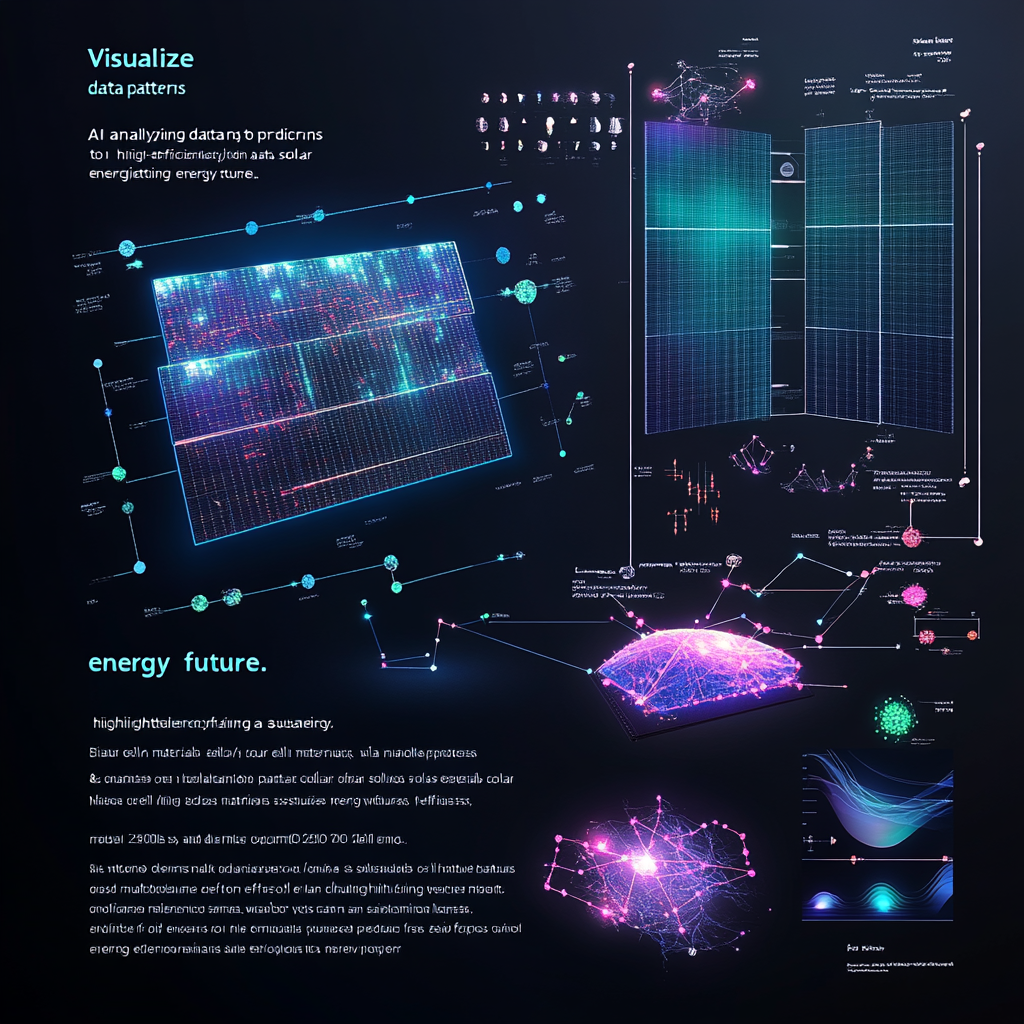
Machine learning precisely predicts material characteristics for high-performance photovoltaics
Machine Learning: The Alchemist of High-Performance Solar Cells
Picture this: the sun blazes down, its rays collapsing into organized symphonies of electrical power. This isn’t the stuff of science fiction; it’s the tantalizing reality being forged in laboratories around the world. As our global need for energy soars, solar technology stands at the forefront of innovation—thanks to a curious ally known as machine learning (ML). Gone are the days of hit-or-miss experimentation; today, advanced algorithms are revolutionizing how scientists predict material characteristics for high-performance photovoltaics. Ready to dive into this fascinating world? Let’s illuminate the journey!
The Marvel of Machine Learning: A New Dawn for Photovoltaics
Solar panels have undergone a major transformation over the years, evolving from clunky behemoths to elegant, high-efficiency machines ready to tackle energy needs. Among these innovative solutions, perovskite solar cells have emerged as rockstars, showcasing efficiencies that could even rival traditional silicon cells. However, these materials face significant hurdles, primarily concerning stability and scalability. This is where machine learning steps in like a superhero in a lab coat.
At the Karlsruhe Institute of Technology (KIT), researchers have developed a deep learning model that acts like a crystal ball for material properties. This isn’t just any ordinary model; it analyzes production data to predict how different materials will perform in real-world conditions. “We can identify process errors before the solar cells are finished,” says Felix Laufer, lead author of this groundbreaking research. That, my friend, is a game changer.
Imagine being able to spot a defect in the manufacturing process before it’s too late, potentially saving millions in material costs. This leap in predictive capability means that the production process becomes more efficient, allowing us to get better products while paving the way for faster scalability.
Explore KIT’s breakthrough and its implications here.
Organic Solar Cells: Accelerating the Quest
Now, let’s shift gears to another frontline warrior of the solar industry—the organic solar cells (OSCs). These beauties are a bit like the wild child of the solar panel family; they offer flexibility and cost-effectiveness but at the expense of efficiency. However, machine learning swoops in like a cool breeze on a hot summer day. Why? Because when it comes to developing new materials for OSCs, speed is everything.
A recent study published in the Journal of Materials Chemistry A takes us into the fascinating world of predictive modeling. Instead of traditional trial-and-error, which feels more like wandering in a maze blindfolded, researchers employed models like random forest and gradient boosting. Using 1,242 combinations of materials, they achieved a Pearson’s correlation coefficient of 0.791 for predicting power conversion efficiency (PCE)—an impressive feat, indeed! When ML algorithms predict with 79% accuracy, it’s like unlocking a treasure chest of high-potential candidates, helping researchers focus their energies on what truly matters.
Forecasting Solar Output: ML as the Weather Whisperer
Machine learning doesn’t just stop at predicting materials; it also pulls double duty as a solar energy output forecaster. Breaking the age-old tradition of sun worship, ML models like CatBoost and XGBoost now help us peer into the future of solar energy generation. By considering diverse weather variables—temperature, humidity, and even the mood of the clouds—these models can fine-tune predictions about solar output.
One study demonstrated that CatBoost achieved an R² score of 0.608, meaning over 60% of the variability in solar output could be explained by its algorithms. That’s impressive! With these precision tools, energy providers can balance their grids more effectively, responding swiftly to fluctuations in solar generation. Imagine a world where your utilities are as sharp as an eagle’s eye, seamlessly adjusting to the whims of the weather!
Overcoming the Odds: Challenges in Material Prediction
But the journey to solar nirvana isn’t without its pitfalls. Major challenges loom, but they’re not insurmountable roadblocks—more like hurdles to leap over. One of the significant issues lies in the diversity of data. Most ML models have primarily been trained on lab conditions that resemble controlled environments rather than the chaotic nature of the real world. For instance, perovskite cells degrade quickly under heat and moisture, but how can we predict longevity if our datasets come exclusively from short-term lab tests?
Another daunting challenge is the complexity of solar metrics. It’s not just about power conversion efficiency anymore; researchers also have to consider factors like stability, cost, and environmental impact. As noted in a review article in Energy & Environmental Science, the diverse chemical structures in organic semiconductors make data-driven design akin to “searching for a needle in a haystack.” With a sprinkle of better data curation and cross-disciplinary teamwork, however, we just might find that needle—or even a diamond!
The Horizon Ahead: Future Possibilities
We’ve explored the present; it’s time to venture into the future. For perovskite cells, the ultimate quest is to achieve the holy grail of high efficiency coupled with long-term stability. Could machine learning help us simulate how material properties degrade over time? We think so! This could lead to the development of protective coatings that stand the test of time and the elements.
For organic solar cells, the focus is on the audacious automation of the material discovery process. What if AI could “evolve” new polymers through virtual screenings that dramatically improve efficiency? The idea of a collaborative robot-and-scientist duo sounds like pure science fiction—but it’s tantalizingly within our reach!
Perhaps the most thrilling prospect lies in hybrid systems. Imagine perovskite-silicon tandem cells enhanced through ML optimizing material interfaces; a kind of material matchmaking if you will. Or consider AI-driven recycling processes mapping out how to reclaim rare metals from old panels. The possibilities are as limitless as our sunny days!
Call to Action: Want to stay up to date with the latest news on neural networks and automation? Subscribe to our Telegram channel: @channel_neirotoken.
Machine learning isn’t merely an accessory in the solar game; it’s the catalytic force that could drive us toward a sustainable energy future. With every insight gained from these sophisticated algorithms, we edge closer to making solar energy not just a viable alternative, but the standard we rely on. The journey has just begun, and it’s bound to be a spectacular ride!

